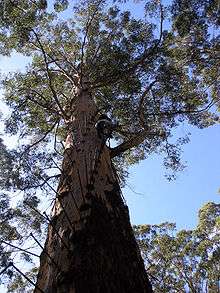Eucalyptus diversicolor
| Karri | |
|---|---|
 | |
| Climbing a famous karri tree - the Gloucester Tree | |
| Scientific classification | |
| Kingdom: | Plantae |
| (unranked): | Angiosperms |
| (unranked): | Eudicots |
| (unranked): | Rosids |
| Order: | Myrtales |
| Family: | Myrtaceae |
| Genus: | Eucalyptus |
| Species: | E. diversicolor |
| Binomial name | |
| Eucalyptus diversicolor F.Muell. | |
Eucalyptus diversicolor, commonly known as the karri, is a eucalypt native to the wetter regions of southwestern Western Australia.
Description
The tree grows to over 80 metres making it one of the tallest trees in the world. It has white to cream bark that turns brown as it matures and is shed. The whitish trunk beneath takes on a patina of colours from white to grey to deep brown. The trunk is without secondary trunks, but occasionally a twin trunk occurs where two trunks of the same diameter grow up from the seedling stage. Mature trees branch only from the top third of the trunk. The leaves are dark green on top and lighter underneath, and grow to a length of 90–120 mm and 20–30 mm broad. The cream-colored flowers occur in groups of seven, each flower measuring about 18–28 mm in diameter. Flowering occurs in spring and summer. The fruits are squat and barrel-shaped, with numerous small dry seeds. The fruit is up to a centimeter long.
The botanical name diversicolor means “separate colours” and refers to the difference between the top of the leaf and its underside while the common name is derived from the Aboriginal name for the tree.
Ecology
The soil in which karri grow is often poor, and the tree tends to flower after fire to take advantage of the nutrients released by the combustion of forest litter. The soil is classified as Karri Loam. Though low in some minor nutrients it is admired for its depth and pasture-growing properties. The depth of the soil is several metres and thought to be created primarily from the bark shed by the tree, which collects at the trunk base to a depth upwards of six metres in mature trees. The karri supports an extensive ecosystem which is connected to the granite outcrops of the lower south-west and the many subsequent creeks and rivers created from runoff. Karri generally dominate in the deep valleys between granite outcrops surrounding the creeks and rivers.
Distribution

Karri occurs only within the High Rainfall Zone of the South West Botanical Province of Western Australia. It mostly occurs within the Warren biogeographic region, but there are some outlying populations, of which the most notable is in the Porongorup Ranges.
Uses

Karri wood is a beautiful mahogany colour, lighter in color than jarrah. It is used extensively in the building industry, particularly in roofs due to the length and uninterrupted knot-free nature of the trunk. It has the reputation of being termite-prone, although it is nowhere near as susceptible to these insects as pine. It is also a great furniture wood. Karri honey is widely sought after for its light color and delicate flavor. Tourism to this area is also supported by the Karri.
See also
- Gloucester Tree, a famous karri tree in Western Australia that has a platform 61 metres above ground level;
- Warren (biogeographic region), also known as the Karri Forest Region.
External links
| Wikispecies has information related to: Eucalyptus diversicolor |
- World Wildlife Fund (2001). "Jarrah-Karri forest and shrublands". WildWorld Ecoregion Profile. National Geographic Society. Archived from the original on 2010-03-08.
- Department of Conservation and Environment - information page.
- "Eucalyptus diversicolor". FloraBase. Western Australian Government Department of Parks and Wildlife.

Further reading
- Boland, D. J., et al. (1984). Forest Trees of Australia (Fourth edition revised and enlarged), CSIRO Publishing, Collingwood, Victoria, Australia. ISBN 0-643-05423-5.